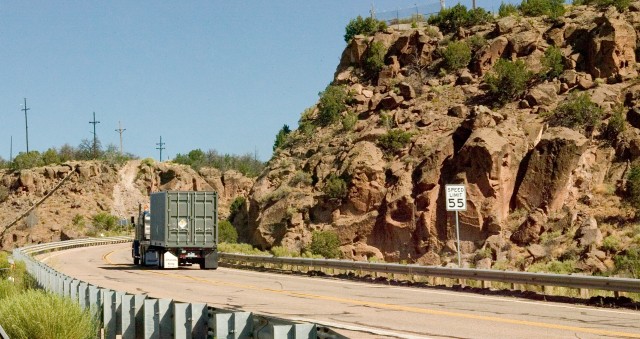A sealed source can be any of several radioactive isotopes encapsulated to prevent leakage. Sealed sources are used for nuclear and general laboratory research and for a variety of medical and industrial applications. They can be found in instruments as varied as pacemakers, moisture and density gauges, oil-well logging equipment, and smoke detectors. Los Alamos National Laboratory experts recovered the sources from private and government institutions and contained plutonium-239.
For shipping, the sources were first placed in stainless steel pipe components and then packed in 55-gallon waste drums. The next step was to enclose the drums in a TRUPACT-II, a cylindrical waste container 10 feet high and 8 feet in diameter. A TRUPACT-II has a stainless steel skin over a 10-inch layer of polyurethane foam that in turn surrounds two internal, nested containers. The waste drums carrying the sealed sources made their trip to WIPP inside those internal containers.
The Off-Site Source Recovery Project (OSRP) at Los Alamos National Laboratory recovers excess and unwanted radioactive sealed sources and other radioactive material from the environment. The project is part of the U.S. Radiological Threat Reduction Program and is led by the National Nuclear Security Administration of the Department of Energy. Los Alamos' OSRP has recovered more than 10,500 radioactive sources, more than two-thirds of the actinide sources known to be excess and unwanted. OSRP expects to recover a total of 18,000 actinide sources by decade's end.
Los Alamos has been the only national recovery site for excess sealed radioactive sources for 25 years. OSRP makes sure unwanted, unused or unsecured sources are recovered and removed from the environment. Sources containing radioactive plutonium, americium, cesium, cobalt and strontium have been recovered from medical, agricultural, research and industrial locations throughout the nation. From Oct. 1, 2002, through March 31, 2004, Los Alamos' OSRP responded to a congressional mandate to recover a total of 5,529 industrial sources from North Carolina, California, Texas and Pennsylvania.
So far during the 2005 fiscal year, 479 sources have been recovered. During the 1980s and 1990s, Los Alamos recovered about 1,100 additional sources under predecessor programs. Excess and unwanted americium-241, plutonium-238, and plutonium-239 sealed sources are transported to Los Alamos or the Nevada Test Site for temporary storage. Qualified sources will be disposed at New Mexico's Waste Isolation Pilot Plant (WIPP). Under the National Nuclear Security Administration's oversight, the OSR project has recovered thousands of sealed sources. The sources are held in secure storage at Los Alamos and at the Nevada Test Site until those that are eligible can be moved to WIPP.
The July shipment was made possible by that exemption's acceptance in 2004 and by the Environmental Protection Agency's approval of OSR project procedures for identifying the radiological contents of all sealed sources. Los Alamos National Laboratory is operated by the University of California for the National Nuclear Security Administration (NNSA) of the U.S. Department of Energy and works in partnership with NNSA's Sandia and Lawrence Livermore national laboratories to support NNSA in its mission.
Note to news media/editors: photo available online at ...
http://www.lanl.gov/news/albums/environment/50AD2782.jpg
CAPTION: First leg of the trip. Drums of excess sealed sources that had been stored at TA-18 begin their trip to WIPP in a trailer bound for TA-54, where the drums will be loaded into a TRUPACT-11 waste container for shipment to the southern New Mexico disposal facility.
http://www.lanl.gov/news/albums/environment/05_50AD2796.jpg
CAPTION: Drums of excess sealed sources arrive at TA-54. Paul Apodoca of NWIS Division’s Transuranic (TRU) program unloads the drums, which at been stored at TA-18, so they can be prepared for shipment to WIPP.
http://www.lanl.gov/news/albums/environment/50AD2853.jpg
CAPTION: Final packaging for WIPP. At TA-54’s Radioassay and Nondestructive Testing (RANT) facility, 14 drums of excess sealed sources are hoisted high in the air to be placed inside a TRUPACT-II waste container (concealed in this photograph behind the closed TRUPACT-II to the left of the RANT workers on the platform). The drums have been wrapped in strips of heavy plastic and stacked 7 upon 7 for packaging. Once sealed, the container of drums left for WIPP aboard a specialized transport trailer at 6 p.m., April 28.
Los Alamos National Laboratory, a multidisciplinary research institution engaged in strategic science on behalf of national security, is operated by Los Alamos National Security, LLC, a team composed of Bechtel National, the University of California, The Babcock & Wilcox Company, and Washington Group International for the Department of Energy's National Nuclear Security Administration.
Los Alamos enhances national security by ensuring the safety and reliability of the U.S. nuclear stockpile, developing technologies to reduce threats from weapons of mass destruction, and solving problems related to energy, environment, infrastructure, health, and global security concerns.


